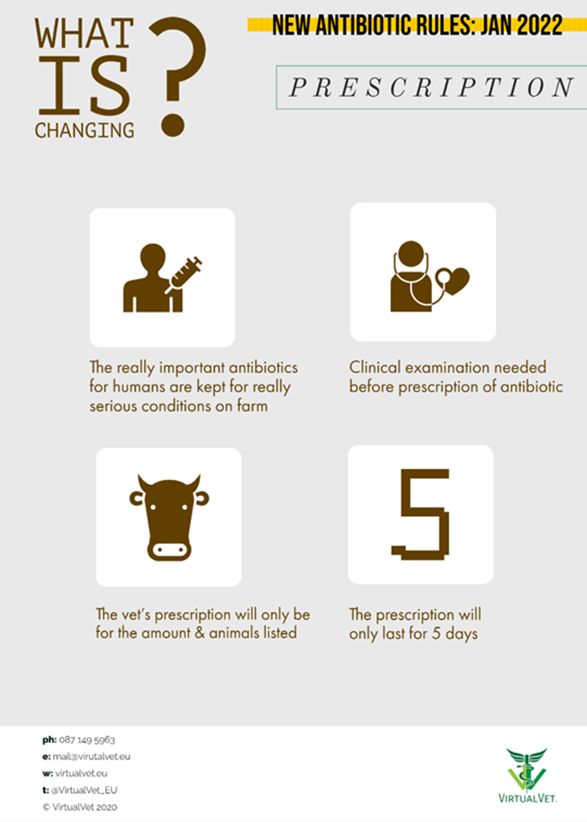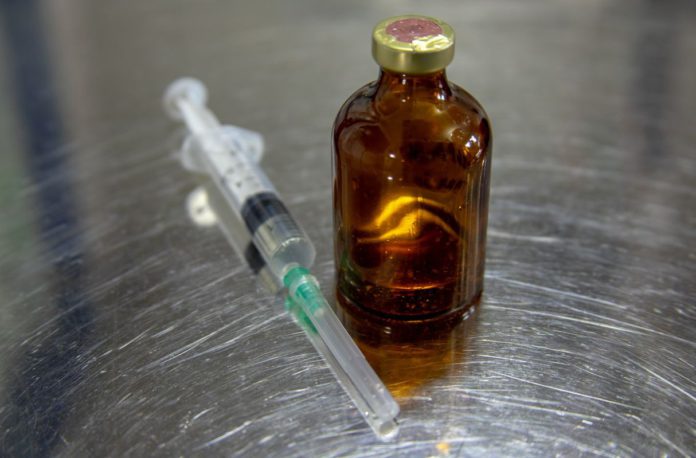January 2022 sees the enforcement of new EU rules on prescribing veterinary medicines, with a particular focus on antimicrobials, including antibiotics, writes Sinead Quealy, managing director of Virtual Vet.
The rule changes are focused on the prescribing practices of veterinary surgeons. However, the impact of the new rules will be felt on-farm as treatment choices may be more limited or delayed.
From January 28th, next vets in the Republic of Ireland and the rest of the EU will be required to consider AMR and its threat to human health ahead of the individual needs of an animal or animals in front of them.
This does not remove:
- Their ability to prescribe antibiotics;
- Nor does it prevent vets and farmers from making animals comfortable through the administration of pain relief and comfort measures.
But antibiotics will require a little more consideration before prescription.
For example, and in accordance with existing Veterinary Council of Ireland professional conduct requirements, an animal must be demonstrably under a vet’s care. The vet must have a “threshold of knowledge” about the animal and its history.
To be clear, every veterinary antibiotic used in treating animals, be they pets or food-producing, is an antibiotic for humans too.
The WHO generally classified these antibiotics as Highest Priority Critically Important Antibiotics (HP CIA) and Critically Important Antibiotics (CIA) to humans.
It is possible that vets may require sensitivity and susceptibility tests before prescribing these antibiotics from January.
Farmers must prepare for possible delays and increased costs for laboratory or practice testing.
These tests are designed to enable vets prescribe the, for want of a better description, oldest antibiotic with the highest chance of success.
The idea is to preserve the use of HP CIAs and CIAs for human healthcare first and foremost.
Also, the tests can shed light on the pathogen itself and guide the vet and the farmer regarding the seriousness of the issue for their farm and wider herd or flock.
AMR
To put the inconvenience of the rules tightening in context, the changes are a response to the growing and acknowledged threat to human, animal and environmental health posed by antimicrobial resistance (AMR).
(For a comprehensive and real-world explainer about AMR and farming, check out this factsheet)
In a crude summary, when you use an antibiotic, while you might kill or limit the growth of some bacteria, in all likelihood, you are actually strengthening some bacteria, causing them to outlive treatments once designed to beat them.
This is resistance—the ability of a pathogen to shrug off your efforts at controlling it.

For vets in Ireland, the changes will be accompanied by a National Veterinary Prescription System (NVPS), to be rolled out by the Department of Agriculture, Food and the Marine (DAFM).
According to their communication, the new web service will allow vets to prescribe more than one veterinary medicine on each prescription, and allow the prescription to be dispensed by more than one dispenser, “such as a licenced merchant premises, a co-op or a pharmacist”.
While this maintains and, in some cases, facilities improved purchasing flexibility for farmers, the likely impacts from restrictions in prescribing have, in our view, not been fully articulated to farmers, nor indeed in some cases to veterinary practice staff.
The 2018 book, The Business of Farm Animal Welfare, includes the chapter, antibiotic use in farmed animals.
The authors set out the welfare impacts attributable to two particular types of antibiotic usage: prophylactic and growth promotion.
The table below, taken from that chapter, presents the impacts on both the animal and wider public health as both uses are drivers of AMR.
While the EU has long outlawed the use of antibiotics as a growth promoter, we must be realistic that the practice is carried out in many markets to which we export and, in some cases, from which we import food products.
Impact on animals and wider public health
| Type of antibiotic use | Direct impact on animal welfare | Indirect impact on animal welfare | Indirect impact on human health |
| Prophylactic | May be positive in short-term as it prevents an animal from falling ill | Enables continuation of low-welfare environment | Contributes to the risk of antibiotic resistance |
| Growth promotion | Negative as puts excessive physiological and metabolic strain on the animal | Contributes to the risk of antibiotic resistance |
Table 1 After Ajuda, Bond & Jewell[1]
Linking animal welfare to antibiotic usage is an important reminder to farmers that they have actions available to them to help reduce the amount of antibiotics their animals may need.

Keep your distance
Active and ongoing prioritisation of cleaning and hygiene on-farm can keep animals comfortable and healthy.
The ‘keep your distance’ advice we have all followed since the outbreak of Covid-19 applies to all viruses and bacterial infections; closeness helps the bugs!
Allowing space and comfort for animals can reduce the chances of any infections inevitably spreading to an entire group.
But there’s an important factor in this balance that the book covers; farming animals is a business.
So the customers of farmed animals, in most cases, processors and retailers, must enable the economics to add up in favour of space and low-input systems.
Sadly, as we know too well, real engagement and rewards from buyers on animal health and welfare criteria are lacking, mostly due to a reluctance to carry out meaningful and supportive purchasing arrangements with farmers or clear communication to customers and consumers.
Antibiotic usage stewardship
In the case of antibiotic usage in their supply chains, the claims of retailers and processors vary and are sometimes based on a lack of understanding of the topic.
A common mistake is to treat testing for antibiotic residue as an example of antibiotic usage stewardship. It is not.
It is simply a test of the producer’s ability to count days on a calendar and observe the correct withdrawal period. It does nothing to influence the usage or not of an antibiotic on-farm.
In fact, because withdrawal periods on some of the HP CIAs are shorter than older antibiotics, there can be undue pressure on vets to prescribe these HP CIAs to reduce the period milk or beef must be withheld from being processed.
Weariness of bearing the brunt of yet more regulations is a very understandable human reaction to another change beyond farmers’ control.
The important farmer-vet relationship will require each side to be open about the uncertainties and strategies needed to ensure the most successful implementation possible of these new regulations (EU Reg 2019/6).
Start preparing now
Our advice would be to start preparing now. Farmers, vets and practice staff can discuss their fears in advance of January.
Perhaps, there may be positive habits already in place on a farm that can be built on or expanded to promote animal health?
Perhaps, one glaring issue needs to be addressed for the benefit of animal, farmers, and the wider community?
It is not all doom and gloom. The choices and changes will truly will reduce the spread of resistance. As we described earlier, the usage of these precious medicines makes some of the bugs stronger.
Reducing usage removes their opportunities for learning.
Saving antibiotics for our loved ones is not a futile exercise. We wish you and your vets every good luck.
More reading
Further information on the author and Virtual Vet.





